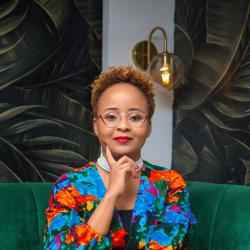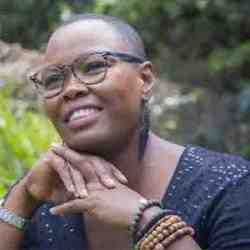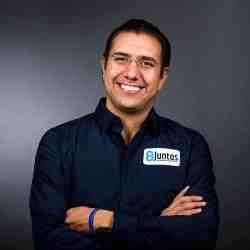Introduction
Contrary to many other parts of the world, such as the U.S., deaf people are highly excluded from French society and are often considered a burden. François Goudenove is changing this mindset. François is pioneering a society in which deaf people are full citizens, prejudices among the hearing towards the deaf have disappeared, and what was once considered a disability is an asset. François’ innovative tools around sign language revolutionize deaf people’s daily lives, restore their self-confidence, and empower them to play a fuller role in society.
L'idée nouvelle
François has developed a comprehensive set of tools that enable deaf people to broadly communicate using sign language. He empowers them to promote their identity. Examples of his innovations include new ways to make video phone calls, using live sign language interpreters, as well as a live news website in sign language. By facilitating communication and the accessibility of sign language, François has restored the autonomy and self-confidence of thousands of deaf people and has enabled them to act on an equal footing with hearing people. Moreover, he is promoting his organization, Websourd, as an integrative role model for deaf people into the mainstream workplace; currently employing 15 deaf people on a team of 20. By recruiting deaf people on their potential and skills, François offers them promising career paths.
In addition to directly serving the deaf community, François encourages hearing people to accept deaf people and feel comfortable with their differences. To break the taboo of deafness as a disability, he enables hearing people to have one-on-one communication with deaf people in sign language in the workplace and in public places. François also promotes sign language through highly visible tools, such as the first sign language avatar interpreter that will soon be accessible on large screens in 150 major French train stations. Furthermore, François creates job opportunities for hearing people to be sign language interpreters (from 280 interpreters today to 3,000 targeted in five years). He is also changing how academic institutions engage around the issue of deafness by developing trainings in sign language, soon to be available in several universities.
To fundamentally change French mentalities towards deaf people François knows he must demonstrate deaf people’s value the whole of society. He is therefore developing training programs based on non-verbal communication skills, led by deaf people (i.e. 1,200 have been trained to date). To further revolutionize the role of deaf people in society, François is proving the value they bring to other sectors. He is working on a project with Airbus to design an airplane cockpit using deaf people’s skills. In the mid-term, technologies developed initially for deaf people will be able to serve other populations (e.g. the elderly), thereby contributing to societal improvement. Beyond his national impact, François is currently working on two projects at a continental scale.
Le problème
There are an estimated 300,000 to 400,000 deaf people in France (i.e. one child out of 1,000 is born deaf). This population remains highly excluded from citizen and economic life; only 4 percent of deaf young people pursue their studies after they receive a high school diploma, while 50 percent are underemployed given their potential. This is partially due to the struggles they often encounter with reading and writing proficiency. Until 2005, the education provided to deaf people was based on oral learning and sign language was forbidden in schools. Communication with deaf people had to be oral, considerably limiting deaf people’s interactions with hearing people outside their family. Daily exclusion from mainstream society strongly limited their autonomy. Exclusion was perceived as an unbearable moral violence by deaf people and led to deaf people progressively losing self-confidence (i.e. as shown by recent sociological studies in France). Exclusion is also one cause for the high rate of unemployment among deaf people (30 percent versus 10 percent of the whole population). However, the accessibility law passed in 2005 brought strong legislation improvements in France and after decades of oral learning, sign language became an official language in the French education system. Today, around 100,000 deaf people are fluent in sign language, as most have chosen this language to communicate within the deaf community.
The very recent acceptance of sign language has had three main consequences: The phenomenon of deaf people acting as an isolated community centered on itself; French hearing society feeling a powerful uneasiness regarding sign language; and, a fundamental lack of sign language interpreters in France. In total, 280 sign language interpreters currently exist in France (one for 200,000 inhabitants), when more than 3,000 would be required to implement the law on accessibility adopted in 2005. With 60 percent of interpreters concentrated in Toulouse and Paris, the lack of interpreters is even more apparent in the other regions. Given this gap, intermediaries are emerging with various profiles offering no guarantee of training or quality translation. New translation technologies represent a huge opportunity to bridge the gap between supply and demand of quality interpretation, particularly since the use of visual tools and the Internet is common within deaf populations.
Sign Language is not a universal language as it is commonly believed. It reflects a country’s culture, history, and geography, as any other language and thus differs from one country to another. Nevertheless, as deaf people have developed a sight-based mental structure (i.e. especially people who were born deaf or became deaf very early in life), the grammatical structure of sign languages is similar across countries. Vocabulary is the only thing that differs, and as it is a pictured language, some vocabularies even converge. Deaf people have therefore developed the capacity to rapidly communicate with other nationalities by inventing, in the moment, hybrid vocabulary. This easy convergence of sign languages and its overall grammatical similarity across countries lend tremendous potential to communication and accessibility solutions based on sign language, both on a continental and global scale.
La stratégie
François’ strategy focuses on working with both deaf and hearing communities and on creating the missing bridges between these two populations to reverse of isolation and stigmatization. To fulfil this mission, François has developed an organization mainly composed of deaf people and based on two goals: Develop tools adapted to deaf peoples’ needs and empower deaf people in the workplace. Websourd is organized by the following divisions:
1) To fight against the isolation of deaf people linked to a lack of daily information, François has created a web portal with 30,000 visitors per month. By providing daily news in sign language deaf people are equipped with up-to-date information about the services available to them. Websourd employs a team of journalists to maintain the web portal.
2) To make sign language more visible and to enable deaf people to access the same level of information as hearing people, Websourd has developed and is spreading the usage of the first sign language interpreter avatar. The technology is already effective in a major train station in Paris (i.e. and will soon be used in 150 French train stations). The tool’s potential application is tremendous: There are hundreds of public places where citizens hear oral messages such as informative updates, advertisements, or urgency messages, whether in stations—train, tube, airport—or other public places such as commercial malls. A team of sign language experts oversee the design and implementation of the avatar tool and its training.
3) To enable deaf people to be autonomous in their public and professional lives—whether by making phone calls, accessing public services, or participating in meetings—a commercial team spreads the Visio technology (i.e. video phone calls facilitated by remote live sign language interpreters) in companies and public offices.
4) To recognize that the needs of the deaf community are continuously changing and evolving— a Research & Development team works on refining tools and developing new innovations.
Some activities, like the Visio, the avatar and the company trainings, are generating revenue which is 100 percent reinvested into Websourd, a social business. These activities make it possible for the organization to finance less profitable activities, such as the website or the R&D, and to guarantee that all the services developed by Websourd are accessible for free to deaf people.
François particularly targets his services and trainings toward companies and public services in order to change the perception of hearing people toward the deaf community within the mainstream workforce. He has been successful in demonstrating the interest of companies and public services in terms of their legal constraints, client relationships, employee satisfaction, human resource policies, and people development, such as company-wide complementary trainings. Companies have shown that they are willing to pay for the new tools, the interpreting hours, access to a sign language database, and the training, and thus participate in changing the perception of deaf people among employees and customers. One example of Websourd’s impact within companies is its trainings led by deaf people, which allow hearing people to learn 10 different non-verbal communication skills, honed by deaf people. The trainings uniquely position deaf people with highly valued skills that hearing people do not naturally have.
Already 40 companies are using VisioPro and the system VisioGuichet is effective in 30 French towns (i.e. in town halls, tax bureaus, and public libraries). François’ trainings have convinced 1,200 people that what used to be considered a disability can also enrich them with new and different skills. Spreading his model, François is negotiating national partnerships with some public institutions (e.g. with family allowances desks located in most French cities) and with large companies to ensure the broad implementation of Websourd tools and a change in sentiment throughout the country.
Reversing a pattern and shifting mindsets requires addressing not thousands, but millions of people. Aware of this challenging path, François has structured his organization to ensure the sustainability of his model while maintaining the quality of sign language interpreting. This requires greatly increasing the number of sign language interpreters in the world. François’ strategy to reinforce interpreting includes two steps: First, provide quality live interpreting under the current constraint for immediate accessibility; second, develop the profession of interpreting while setting quality standards. For the second stage, François is creating partnerships with all stakeholders, such as universities to spread the teaching of sign language, with interpreter companies to provide complementary trainings, and with job agencies to source unemployed people as potential interpreters and offer them a high value job. He is also supporting interpreters in developing their own interpreting franchises that work with Websourd (i.e. with the ambition of reaching one interpreting cooperative structure of 20 interpreters per French sub-region in five to eight years). Not only is this expansion strategy of Sign Language interpreters critical in enabling François to spread his model, but most important, it contributes to making sign language a common academic study and interpreting a job opportunity for a growing number of hearing people.
The potential reach of François’ solutions extends beyond national scale and he is currently working on projects at a European level. With four foreign partners in Belgium, Spain, Poland, and Austria, he participates in improving the training of deaf people, especially on new technologies. Working with 22 other partners across Europe, François continues to innovate for continued accessibility to communication by playing a key role in a European project on emergency phone numbers for deaf populations.
Websourd is centralized in Toulouse, which is considered to be the deaf peoples’ capital in France, and even throughout Europe, as it gathers a huge deaf population. This central location has contributed to placing Websourd as a cornerstone of the “deaf people Silicon Valley.” From Toulouse, François is well-positioned to set standards for high-quality accessibility and communication services for deaf people beyond French borders.
La personne
Originating from a working class background in the North of France, François received an education strongly based on France’s integration principles, beginning with speaking French. But he has also been instilled with teaching from his mother patois, Chti, the traditional language in the North of France. François’ mother led a theater company in Chti and despite the fact that François and his brothers loved hearing and talking Chti, it was forbidden for them to do so outside their family home. As a child, he was included in numerous social activities with his father and naturally developed a sense of sharing. It contributed to his choice not to do his military service during one year, but to instead spend two years in Africa math classes. François was thrilled by the experience of sharing his knowledge and fascinated by the way some words could have different meanings in different cultures.
Returning to France, François moved to Toulouse after hearing a song by the famous Claude Nougaro. Embracing the adventure of setting up in an unknown city, he quickly found a job at Airbus, where he spent 15 years with increasing responsibilities at a European level. François soon left his technical role, which he took due to his engineering background, to assume the role of a go-between, to facilitate the co-habitation of 44 nationalities with different backgrounds, culture and languages working at Airbus. He became passionate about the incapacity of many people to communicate and the levers to solve that issue.
When François’ third son was born deaf, he spent two years hearing from a doctor that his son suffered from autism. Finally discovering that his son was deaf and not autistic, François rapidly began to understand the challenges of oral learning and sign language. Confronted with all the difficulties linked to integrating deaf people and the choices for deaf children’s parents, François created an association to help and orient parents about their options. Meeting Jacques Sangla, a reference in the deaf community, he immediately shared his vision and decided to transform the concept of Websourd from an idea to a viable and large-scale activity. François’ long experience at Airbus enabled him to benefit from high credibility and develop his leadership in a world mostly dominated by deaf people.
François’ story is reminiscent to that of Graham Bell, the inventor of the telephone. Graham Bell had a deaf mother and worked all of his life create sounds to help deaf people. Paradoxically, he created the phone. François’ ambition is to fulfill Bell’s initial goal to better reintegrate deaf people into society, bringing their unique value to the hearing world.



